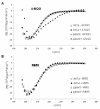Rrd1 isomerizes RNA polymerase II in response to rapamycin
- PMID: 21129186
- PMCID: PMC3019149
- DOI: 10.1186/1471-2199-11-92
Rrd1 isomerizes RNA polymerase II in response to rapamycin
Abstract
Background: In Saccharomyces cerevisiae, the immunosuppressant rapamycin engenders a profound modification in the transcriptional profile leading to growth arrest. Mutants devoid of Rrd1, a protein possessing in vitro peptidyl prolyl cis/trans isomerase activity, display striking resistance to the drug, although how Rrd1 activity is linked to the biological responses has not been elucidated.
Results: We now provide evidence that Rrd1 is associated with the chromatin and it interacts with RNA polymerase II. Circular dichroism revealed that Rrd1 mediates structural changes onto the C-terminal domain (CTD) of the large subunit of RNA polymerase II (Rpb1) in response to rapamycin, although this appears to be independent of the overall phosphorylation status of the CTD. In vitro experiments, showed that recombinant Rrd1 directly isomerizes purified GST-CTD and that it releases RNA polymerase II from the chromatin. Consistent with this, we demonstrated that Rrd1 is required to alter RNA polymerase II occupancy on rapamycin responsive genes.
Conclusion: We propose as a mechanism, that upon rapamycin exposure Rrd1 isomerizes Rpb1 to promote its dissociation from the chromatin in order to modulate transcription.
Figures







Similar articles
-
The peptidyl prolyl isomerase Rrd1 regulates the elongation of RNA polymerase II during transcriptional stresses.PLoS One. 2011;6(8):e23159. doi: 10.1371/journal.pone.0023159. Epub 2011 Aug 24. PLoS One. 2011. PMID: 21887235 Free PMC article.
-
RNA polymerase II degradation in response to rapamycin is not mediated through ubiquitylation.Biochem Biophys Res Commun. 2011 Sep 23;413(2):248-53. doi: 10.1016/j.bbrc.2011.08.079. Epub 2011 Aug 23. Biochem Biophys Res Commun. 2011. PMID: 21884683
-
The isomerase Rrd1 mediates rapid loss of the Sgs1 helicase in response to rapamycin.Biochem Cell Biol. 2011 Jun;89(3):332-40. doi: 10.1139/o11-006. Epub 2011 Jun 6. Biochem Cell Biol. 2011. PMID: 21639830
-
The Ess1 prolyl isomerase: traffic cop of the RNA polymerase II transcription cycle.Biochim Biophys Acta. 2014;1839(4):316-33. doi: 10.1016/j.bbagrm.2014.02.001. Epub 2014 Feb 12. Biochim Biophys Acta. 2014. PMID: 24530645 Free PMC article. Review.
-
The CTD code of RNA polymerase II: a structural view.Wiley Interdiscip Rev RNA. 2013 Jan-Feb;4(1):1-16. doi: 10.1002/wrna.1138. Epub 2012 Oct 5. Wiley Interdiscip Rev RNA. 2013. PMID: 23042580 Review.
Cited by
-
The histone H2B Arg95 residue links the pheromone response pathway to rapamycin-induced G1 arrest in yeast.Sci Rep. 2022 Jun 15;12(1):10023. doi: 10.1038/s41598-022-14053-9. Sci Rep. 2022. PMID: 35705668 Free PMC article.
-
Characterization of ypa1 and ypa2, the Schizosaccharomyces pombe orthologs of the peptidyl proyl isomerases that activate PP2A, reveals a role for Ypa2p in the regulation of cytokinesis.Genetics. 2012 Apr;190(4):1235-50. doi: 10.1534/genetics.111.138040. Epub 2012 Jan 20. Genetics. 2012. PMID: 22267499 Free PMC article.
-
RNA polymerase II C-terminal domain: Tethering transcription to transcript and template.Chem Rev. 2013 Nov 13;113(11):8423-55. doi: 10.1021/cr400158h. Epub 2013 Sep 16. Chem Rev. 2013. PMID: 24040939 Free PMC article. Review. No abstract available.
-
The peptidyl prolyl isomerase Rrd1 regulates the elongation of RNA polymerase II during transcriptional stresses.PLoS One. 2011;6(8):e23159. doi: 10.1371/journal.pone.0023159. Epub 2011 Aug 24. PLoS One. 2011. PMID: 21887235 Free PMC article.
-
TAL effectors target the C-terminal domain of RNA polymerase II (CTD) by inhibiting the prolyl-isomerase activity of a CTD-associated cyclophilin.PLoS One. 2012;7(7):e41553. doi: 10.1371/journal.pone.0041553. Epub 2012 Jul 20. PLoS One. 2012. PMID: 22911812 Free PMC article.
References
-
- Saylor PJ, Michaelson MD. New treatments for renal cell carcinoma: targeted therapies. J Natl Compr Canc Netw. 2009;7(6):645–656. - PubMed
-
- Ramotar D, Belanger E, Brodeur I, Masson JY, Drobetsky EA. A yeast homologue of the human phosphotyrosyl phosphatase activator PTPA is implicated in protection against oxidative DNA damage induced by the model carcinogen 4-nitroquinoline 1-oxide. J Biol Chem. 1998;273(34):21489–21496. doi: 10.1074/jbc.273.34.21489. - DOI - PubMed
-
- Rempola B, Kaniak A, Migdalski A, Rytka J, Slonimski PP, di Rago JP. Functional analysis of RRD1 (YIL153w) and RRD2 (YPL152w), which encode two putative activators of the phosphotyrosyl phosphatase activity of PP2A in Saccharomyces cerevisiae. Mol Gen Genet. 2000;262(6):1081–1092. doi: 10.1007/PL00008651. - DOI - PubMed
Publication types
MeSH terms
Substances
Grants and funding
LinkOut - more resources
Full Text Sources
Molecular Biology Databases
Research Materials

